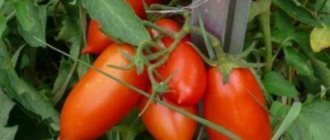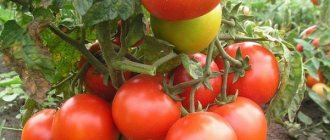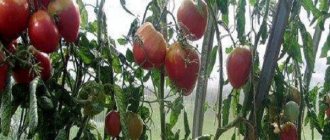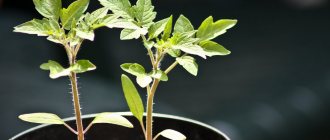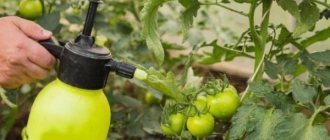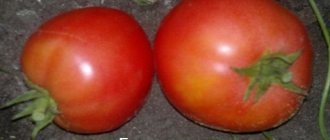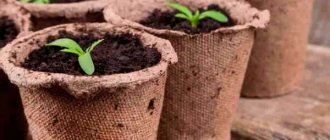Description of the variety
The main characteristics of the variety include the following:
- determinant, mid-season (100 – 115 days);
- does not have similar hybrid varieties;
- the bush is short (80 cm in open ground and 100 - 180 cm in a greenhouse), not standard; the seedlings are frail, but then grow stronger, there are few leaves; 3 – 6 fruits are tied on one hand;
- grows in all regions, withstands drought, frost and rain, takes root well in field and greenhouse conditions;
- the fruits are large (400 - 1000 g), raspberry color, heart-shaped, the skin is thin and strong, there are few seeds, the flesh is fleshy;
- fruit taste: sweet, universal;
- Application: both fresh and for preparing preserves and various dishes;
- the harvest period lasts all summer;
- yield: up to 10 kg per plant (with good care);
- The fruits tolerate transportation and storage well.
Description of the Buffalo Heart tomato and cultivation in open ground
The Buffalo Heart tomato is a low-growing but large-fruited variety. It was bred by Russian breeders at the beginning of the 21st century. This variety has many advantages, for which it has received positive reviews from vegetable growers. It is low-growing, but bears large fruits, similar to a heart. Refers to non-hybrid vegetable crops. You can save the seeds for planting next season.
Characteristics of the variety
The characteristics and description of the variety are as follows:
- Buffalo Heart tomatoes are intended for cultivation throughout Russia. There are no special recommendations for choosing a region. The variety takes root and produces good fruits both in the northern regions and in the south.
- Medium early tomatoes. The plant begins to bear fruit 115 days after planting the seedlings. Summer residents receive their first harvest in July.
- Tomatoes are planted both in a greenhouse and in open ground. It is not dependent on weather conditions. Withstands slight drought, rain and frost.
- The variety is determinate, that is, low-growing. The bushes are standard, rather frail. There are few leaves. The average plant height is about 80 cm; in greenhouses, a tomato grows up to 1 m.
- Buffalo Heart tomatoes are practically not susceptible to common diseases and insect pests. This makes the variety attractive to both experienced gardeners and beginners.
Buffalo Heart tomatoes are a rich red color with a hint of pink.
- These are large, round-heart-shaped tomatoes.
- Each fruit weighs from 500 g to 1 kg.
- The pulp is dense, fleshy, juicy.
- Minimum number of seeds and chambers.
- The peel is smooth, glossy, thin.
- Classic tomato taste.
- The tomato is sweet with pleasant sourness.
- 3-5 tomatoes are tied in one brush.
- They ripen well and are stored at home.
- They can handle transportation without any problems.
The variety bears fruit for a long time. Summer residents who grow Buffalo Heart from mid-summer to early autumn always have fresh tomatoes on their table. This property of the variety also makes it suitable for commercial cultivation. Productivity is good. With proper care, one bush produces 10 kg of fleshy tomatoes per season. The variety belongs to the salad variety.
Buffalo heart is not suitable for preservation due to the large size of the fruit. Dishes prepared from tomatoes:
- Various salads.
- Tomato paste.
- Juice.
- Sauces.
- Snacks.
- Ketchup.
How are tomatoes grown?
The Buffalo Heart tomato is planted in open ground as seedlings. Seeds are planted in boxes with soil in March. Each seed is sown to a depth of 1 cm. The soil for the tomatoes is fertile. Then water it with a spray bottle and cover it with film to create comfortable conditions for seed germination.
Within a week, shoots should appear. As soon as several strong leaves grow from each seed, the seedlings can be planted in separate cups. Seedlings are transplanted into open ground or a greenhouse 2 months after planting. The plants should first be hardened off and accustomed to the street. To do this, a few weeks before transplanting them into open ground, they begin to take them outside or onto the balcony.
The hardening time is gradually increased. This way, replanting will not cause stress to the plants, and the tomatoes will take root better. Everyone who has planted this species says that the seedlings are noticeably different from other varieties. The shoots are quite thin and long. As soon as the plant is transferred to the ground, it gains strength.
Bushes are placed 4 pieces per 1 m². During planting, the plants are fed with fertilizers, the ground is sprinkled with ash, and the holes are watered abundantly. Tomatoes are watered with warm water once every few days. The Buffalo Heart variety loves moderate watering. However, you need to ensure timely removal of weeds and loosening of the soil under the bushes.
The variety is not susceptible to the most common diseases. However, it is best to prevent diseases. To do this, the plant is treated with insecticidal substances.
A greenhouse or greenhouse must be ventilated periodically to avoid causing mold.
High humidity in a greenhouse will not benefit the vegetable crop. In good weather, the greenhouse is opened for the whole day and closed only at night. To increase the yield, the bushes are fed several times a season with fertilizers, which can be purchased in specialized stores.
Advantages and disadvantages
- The advantages of the variety include:
- ease of care;
- undemanding to conditions;
- resistance to disease, drought and frost;
- non-hybrid: high germination of own seeds;
- high yield rates;
- the harvest lasts all summer;
- good taste of fruits;
- universal use in cooking;
- good transportability and long shelf life.
- The only disadvantages include:
- large fruits are not suitable for canning in their entirety;
- Without fertilizing, the fruits become smaller.
Sowing seeds for seedlings
To be confident in the future harvest, it is best not to buy seedlings, but to grow them yourself. Since “buffalo heart” is not a hybrid, seeds for planting do not need to be purchased every year; they can be collected from tomatoes grown by yourself. Judging by the reviews of experienced gardeners, their own seeds have even better germination than purchased ones. Regardless of whether the seeds are bought in a store or collected from your own fruits, they are sown according to the same pattern.
Also, determinant varieties include: “Dubok”, “Balcony Miracle”, “Torbey”, “Gina”, “Stolypin”, “Belyi Naliv”, “Ogorodnik”, “Tatyana” and “Sanka”.
The soil
The choice of soil for sowing must be taken seriously. It should be nutritious and loose. If you buy a special substrate for tomatoes, you can be sure of its balanced composition. If you prepare the soil yourself, it must meet the following requirements:
- composition: peat, soil from the garden, sand and humus in a ratio of 2:1:1:0.5, with the addition of complex fertilizer (with a high content of phosphorus and potassium and a minimum of nitrogen);
- the prepared soil should be disinfected: steamed in a double boiler a week before sowing;
- the earth mixture should be loose, allow air to pass through and absorb water well: add soil disintegrants (sphagnum, vermiculite or coconut).
Deadlines
Seeds need to be sown 60 - 70 days before planting seedlings in open or closed ground. If sowing is carried out in March, then the harvest of greenhouse “hearts” can be harvested as early as June. For an open area, the seeds are sown a little later. Approximately 7 days after sowing, the first shoots should appear. When the sprouts have 2 true leaves, they need to be picked separately.
Growing container
To grow tomatoes you will need two types of containers:
- for sowing seeds before picking: special or homemade boxes, trays, cassettes, the height of the walls is 8 - 10 cm;
- for pickled seedlings: disposable plastic cups, seedling pots, peat pots, the size of which is at least 12 x 17.
Important! Both seed boxes and pick pots should have drainage holes.
Seed preparation
The germination of seeds depends on their quality. If you buy seeds from a reliable manufacturer, they should already be completely ready for planting. Seeds of dubious origin and those collected from your own garden must be prepared for sowing. Usually several preparatory stages are carried out:
- culling: only undamaged seeds of the correct shape and the same color are selected. They are lowered into a bowl with salted water; specimens suitable for sowing sink to the bottom;
- disinfection in one of the disinfecting solutions for 20 minutes: potassium permanganate (pink solution), hydrogen peroxide (2% warm solution) or aloe juice (50% aqueous solution);
- soaking in growth-stimulating nutrients overnight (Epin, Immunocytofit, Virtan-Micro, potato juice, aloe juice are suitable);
- germination: spread the seeds soaked in a growth stimulant or simply in water on a wet cloth and place in a warm place until the sprouts hatch;
- hardening: change the temperature sharply within 3 days (put it on the bottom shelf of the refrigerator at night, and again in a warm place for the day).
Performing 2 or 3 of the listed actions will already increase the percentage of seed germination.
Sowing seeds
A box or other container for sowing seeds is filled with pre-disinfected substrate and moistened. Seeds are sown according to the following scheme:
- groove depth: 1 – 1.5 cm;
- distance between furrows: 3 – 4 cm;
- distance between seeds in a row: 1.5 – 2 cm.
The planted seeds are sprinkled with soil and sprayed with water from a spray bottle.
The box is covered with glass or film and placed in a warm place until the crops sprout. Important! If planted too densely, the seedlings will become very elongated and become vulnerable to fungal infections.
Seedling care
Before planting seedlings in a permanent place, they need careful care. She needs the right conditions:
- The location does not matter until seedlings appear. The main thing is to be warm. When they hatch, it is advisable to place the box on a bright windowsill.
- Temperature: seedlings are comfortable at +22°C during the day and at +16°C or +18°C at night.
- Lighting is required for 12 hours a day. If there is no sunny windowsill, you can use phytolamps, which should hang at a distance of 50 cm from the seedlings. For the first 3 days after germination, it is advisable to illuminate the seedlings around the clock.
- You need to water with settled water at room temperature as the soil dries. Only peaked sprouts need watering once every 7 days. And when they have 5 leaves, water them once every 4 days. You need to moisten the soil, but not the bush.
- You can feed 2-week-old seedlings with a weak solution of complex fertilizers (this includes Agricola, Plantafol, Master) no more than once every 10 days.
Hardening of seedlings
A few weeks before planting seedlings in the garden (at least 2 weeks), you need to start hardening them. This can be done by taking the container with young tomatoes out into the fresh air (on the balcony, in the yard in a shaded place). Gradually, the duration of the procedures should increase. Hardened plants experience less stress from replanting, take root faster in a new location and are not susceptible to disease.
Tomato Buffalo Heart
I appreciate the Buffalo Heart tomato for its excellent taste. Reminds me of “Bull’s Heart”, also large and sweet. I buy seeds from the “Ural Summer Resident”, I like their germination and the varieties are selected for our region, I live in the Urals. I always strengthen the seedlings with a special lamp, and in the greenhouse I put organic fertilizers in the holes. The maximum fruit weight was 650 grams. Some gardeners bring it up to kg, but such sizes can be obtained if there are literally a couple of fruits in total on the bush. For me, several medium ones are better than 1 large one. It gives a harvest until autumn, there are a lot of brushes, a garter is needed.
I have been growing the “Buffalo Heart” tomato variety for 10 years in my garden. I tried to grow it both in a greenhouse and in open ground. In the ground it grows up to 80 cm tall, in a greenhouse up to 1.2 meters. The variety is mid-early, but my other mid-early varieties ripen faster. It bushes weakly, and if pinching is done, it is done very moderately. The seedlings are thin, tall, and resemble the “Bull’s Heart” variety. It grows quickly in the ground. The fruits are sweet, ripen to a deep red color, and are large in size. In soil up to 300 grams you can grow fruits in the Non-Black Earth region, and in a greenhouse on average 500 grams. The taste of greenhouse tomatoes is better than those grown in open ground. I give preference to a greenhouse; it is safer to grow in it - in case of heavy rain, hail, or temperature changes, it is easy to close it and save the harvest. In a greenhouse, this variety can produce fruits up to kg, but this is possible in the first wave of the harvest, the next 2 waves produce smaller fruits, but everything is relative - here the smaller fruits are larger than many other varieties that I grow. I always leave the largest fruit for seeds. I usually grow from my own seeds for 3-4 years, then they degenerate, and I buy store-bought ones.
I like the “Buffalo Heart” tomato, it is productive and large-fruited. For the first time I bought seeds from the Ural Summer Resident company, then I only make my own. The fruits are very tasty, sweet, large, fleshy, with thin skin. I can’t get fruits up to kg even in the greenhouse, but 300-500 grams grow well. Autumn fruits are the smallest, up to 300 grams, they are stored for the winter. The first summer harvests are completely fresh - I make salads, sauce from them, squeeze out the juice, simply cut them into slices and eat them with salt. The variety also grows in open ground, the bush is not tall, but I have a greenhouse and use it for earlier planting and harvest.
I’ve been growing “Buffalo Heart” tomatoes for three years now and every time I’m happy to harvest them. The tomatoes grow very large and sweet, so fleshy. Sweet pink heart, but unlike other tomatoes of this kind, buffalo hearts have a thick skin and store well. I haven’t tried salting them, they won’t fit in jars, so I preserve them in pieces with cucumbers. I start sowing seedlings in March; I buy special soil for vegetables. I transplant the formed seedlings into a greenhouse and harvest the first harvest in July. They bear fruit for a long time; we still eat fresh ones in September. There are a lot of tomatoes on the bushes, all quite large. It happens that a 10 kg bucket comes out of a bush. “Buffalo Heart” doesn’t hurt, but I definitely treat it. I water it moderately to avoid cracking. The bushes are growing powerful, I definitely need to tie them up. Care as for any other tomato variety. You don't need to do anything special. Everything in moderation and the result will please you. I tried to grow it in the garden, but our summer was later, so it was more trouble, the seedlings stood longer and the tomatoes were not so large and tasty. They didn’t have enough sun to ripen, so only in my greenhouse.
I liked the variety and now I’m collecting my own seeds. I once took it from the Siberian Garden company. Here in Siberia, in order to grow a large-fruited tomato, you need to plant it in a greenhouse. The Buffalo Heart tomato can be grown in open ground. I planted 10 pieces each in a greenhouse and in open ground. I tied up the plant, it is small. However, he gives a lot of stepchildren! I formed a tomato plant into 2 bushes and regularly removed the shoots. They bloomed well in the greenhouse, but had to be sprayed with the flowering stimulator “Ovary”. In mid-August, the tomatoes in the greenhouse began to sing a little. I collected it selectively, as it ripened, the fruiting was extended. Forms 4 or more tomatoes on the bunches. With good feeding and watering, you can get 2-3 tomatoes of 800 - 900 grams. Each bush produced several large tomatoes, but the rest were 150-200 grams each. These are fleshy, sweet, almost chamberless and seedless tomatoes. They are good fresh. Their skin is thin, but they are stored for a long time. They all didn’t ripen in the open ground, so I left them to ripen. We used them until November. I liked this variety: unpretentious, the tomatoes are tasty and meaty. Very responsive to fertilizing, constantly fertilized with organic matter.
Planting seedlings in a permanent place
The seedlings are ready to “move” to a new place when they are at least 2 months old. At this age, the height of the stems reaches approximately 30 cm, and they have 7–9 strong leaves. Heart seedlings often look long, thin and frail, but after transplanting they become stronger. “Buffalo heart” seedlings are planted in open ground when there is no longer a threat of frost and the weather is consistently warm. Usually this is the end of May or the beginning of June.
Find out why tomatoes in a greenhouse don't turn red.
In greenhouses, planting is carried out 2-3 weeks earlier. A place for tomato beds must be selected and prepared in advance. Pink "heart", like other tomatoes, loves sunny places, protected from strong winds. It does not like wet soils in lowlands.
Therefore, it is better to plant them on hills where groundwater does not reach. A suitable soil option is loamy soil, which has been previously fertilized with organic matter or mineral fertilizers. Bushes of this variety love space. Therefore, the planting scheme is as follows: 3 – 4 seedlings per 1 square meter. Each hole should be fertilized, sprinkled with ash and watered well.
Features of cultivation
Growing healthy, strong seedlings is only half the battle. To get the most out of it, you need to continue to properly care for it. “Buffalo Heart” is a rather unpretentious variety and does not require special attention. It has the same care needs as other tomatoes.
Watering
“Heart” does not like a lot of water, so it should be watered sparingly. Until fruit set, watering consists of moistening the soil approximately 1 – 2 times a week. During the period of fruit growth and ripening, the bushes need to be watered more often and more abundantly. For tomatoes, how and when they are watered is important.
Water should be poured from below under the root. You can’t wet the entire bush; the plant doesn’t like it. If you water it from above, this can lead to undesirable consequences: a fungal infection, the flowers will fall off, and the fruits will set and ripen slowly. Irrigation water should be warm and settled. The best time for the procedure is morning and evening.
Feeding
Starting from the 10th day in a permanent place (in a greenhouse or garden), the seedlings can be fed regularly. At different periods of tomato development, different feedings are suitable:
- nitrogen fertilizers are necessary for seedlings to grow green mass; they are suitable during the growth period of bushes;
- Potassium and phosphorus fertilizers are necessary during flowering and fruit set;
- bird droppings solution is a universal fertilizer that contains all the nutrients tomatoes need.
Read more about how to feed tomatoes with yeast.
Stepsoning
“Buffalo Heart”, like a large-fruited tomato, needs pinching, that is, removing excess stepsons. Experienced gardeners advise growing bushes of this variety into two stems. This means that all but one side branch is removed regularly. Clusters of fruits develop on the main stem and the remaining side branch.
A pinched plant spends its reserves of nutrients not on the growth of unnecessary branches, but on the development and ripening of fruits. Tomatoes on such bushes are large and ripen earlier than without pinching. The frequency of the procedure is once every 10 days.
Video: pinching tomatoes
Soil care
The usual soil care measures are also mandatory:
- weeding weeds as they grow so that they do not interfere with the development of the tomato crop;
- loosening the soil around the bushes after each watering saturates the soil with oxygen and allows it to warm up well;
- mulching with peat, straw or sawdust retains moisture in the ground, which means it reduces the cost of effort, time and water for irrigation;
- Hilling helps the penetration of oxygen into the soil and its nutrition, promotes the growth and strengthening of roots and stems.
Tying up a bush
Although “buffalo heart” is considered a low-growing variety, it still needs staking. There are several reasons for this:
- under the weight of large and heavy fruits, the branches may not be able to withstand and break, but the support will prevent this;
- the fruits of the lower tier will not lie on the ground and rot;
- the tied plants are well straightened, so the tomatoes receive enough sunlight and fresh air;
- It is easier to care for tied bushes: water, hill, mulch.
There are different ways to garter bushes, which are suitable for different varieties and different numbers of seedlings. For a low pink “heart,” a classic system of pegs is suitable, which should be 20–30 cm higher than the plants. Each support is fixed near a separate bush, and branches are freely tied to it. You can start tying up seedlings in about a week, when they have adapted to the new place.
Preventative treatment
One of the significant advantages of the buffalo heart variety is its resistance to tomato diseases and pests. But due to errors in planting or caring for seedlings, you can provoke the development of one of the fungal diseases (for example, late blight, black leg, septoria or brown spot).
How to grow tomatoes
After 2 months, when the height of the sprouts is at least 30 cm and they have 7-8 leaves, they are ready for transplanting. And again, there is no need to be alarmed that the seedlings are tall, long and seemingly unhealthy. Once you transplant them into open ground, they will begin to strengthen.
Transplant seedlings into the ground after the threat of the last frost, when warm weather sets in. Basically, this is the middle - end of May.
The culture loves loamy soil, pre-fed with organic matter or minerals. Planting scheme: 3-4 seedlings per 1 sq. m. The holes are well watered and sprinkled with ash.
Until the ovaries, water 2 times a week with a small amount of settled water. During fruit ripening, water more often and more abundantly. Water at the root, otherwise the likelihood of fungal infections increases. Overmoistening of the soil negatively affects the taste of tomatoes; they become watery.
What violet is called a pansy, photo of the flower and care features
To keep moisture in the soil longer, the beds are mulched.
From day 10, young bushes begin to be fed regularly. During the period of growth and development of bushes, nitrogen fertilizers are used as top dressing. They promote healthy growth and green growth. During flowering and ovaries, fertilizers are changed to potassium and phosphorus.
Organic matter - bird droppings or mullein infusion - is considered a universal fertilizer: it contains all the necessary nutrients. Organic fertilizers are good for plants throughout the growing season.
After watering, it is necessary to loosen and remove weeds with roots. Loosening helps warm the earth and saturate it with oxygen. Hilling up the bushes helps oxygen penetrate to the roots, which has a beneficial effect on the growth and development of the bush.
Culture requires mandatory stepsoning. It is recommended to keep bushes with 2 stems. This means that all side brushes are removed. In this case, nutrients are spent on the formation and mass of the vegetable, and not on the growth of unnecessary branches. Stepping is carried out once every 10 days.
Despite the fact that the species is short, gartering of the wrists is required. Which is not surprising, considering the mass of fruit. The garter is tied to wooden stakes installed next to the plants.
Diseases and pests
The vegetable crop has proven itself to be unusually resistant to diseases characteristic of the nightshade family. It is also resistant to attacks from insect pests. Therefore, it remains only to briefly mention the necessary preventive measures in the event of a massive pest invasion. And fungal spores can take completely unprotected plants by surprise. Preventive measures are a kind of barrier, an obstacle to infection.
Fitosporin is a good barrier against late blight. It will not protect the plant from disease, but it will also destroy the cause of the disease. Alternative options are “Quadris” or “Revus”.
There are many traditional methods for parasites that are no less effective than treatment with insecticides. For example, tobacco dust, which is used to cover the beds, repels insects. Treating the stems with a soap solution works well against aphids. Spraying with a weak solution of vinegar repels insects with a pungent odor, as does planting fragrant herbs next to tomatoes.
Harvesting
Greenhouse “hearts” begin to be collected already in June, and garden ones - in July. Alternate ripening of the fruits lasts all summer and until the autumn cold. If you followed all the rules when sowing seeds, planting seedlings and caring for them, and the weather conditions were favorable, then over the entire harvest season you can harvest about 10 kg of giant tomatoes from one bush.
The “buffalo heart” variety is profitable to grow both for yourself and for commercial purposes. And although the process requires some effort, this work will not be in vain. The reward will be a bountiful harvest of large and tasty tomatoes.


